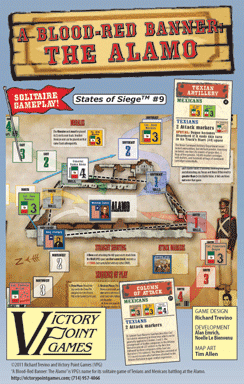A Blood-Red Banner: The Alamo (2011) Board Game
A Blood-Red Banner: The Alamo is a wargame that simulates the famous battle of the Alamo during the Texas Revolution in in 2011. Players take on the roles of either the Texan defenders or the Mexican attackers in this historically significant event.
Game Components of A Blood-Red Banner: The Alamo
How To Setup A Blood-Red Banner: The Alamo
Setting up the game is quick and straightforward. It takes no more than a couple of minutes to lay out the handful of counters and shuffle the 24 event cards. The map is placed on the table, and the Mexican units start off-board, to be introduced as indicated by the event cards.
Gameplay Mechanics and Game Objective
– Event card flipping to determine Mexican column movements
– Die rolling to resolve attacks on the Alamo
– Hero movement and attacks
– As the Texian defenders, the player must delay the Mexican army’s capture of the Alamo as long as possible.
– Victory is measured by the number of event cards remaining when the mission is captured, with two or fewer cards indicating a Texian moral victory.
Player Experience
Playing **A Blood-Red Banner: The Alamo** can feel somewhat deterministic, as the Alamo’s fall is inevitable. The game involves minimal decision-making, with players mainly moving heroes and choosing which Mexican columns to attack to slow down the advance. The gameplay is simple, with each turn involving flipping an event card, moving Mexican columns, and performing defensive actions. However, this simplicity can also make the game feel less engaging, as the outcome is largely predetermined.
Pros
Cons
Personal Thoughts on A Blood-Red Banner: The Alamo
**A Blood-Red Banner: The Alamo** is best suited for those who are new to solitaire games or the States of Siege series, or for history enthusiasts interested in the Battle of the Alamo. However, players seeking complex decision-making and dynamic gameplay may find this game too simplistic and less engaging. Despite its historical appeal, the game’s deterministic nature and lack of significant player influence can make it feel more like a historical simulation than an interactive game.
We are supported by our audience. When you purchase through links on our site, we may earn an affiliate commission, at no extra cost for you. Learn more.

